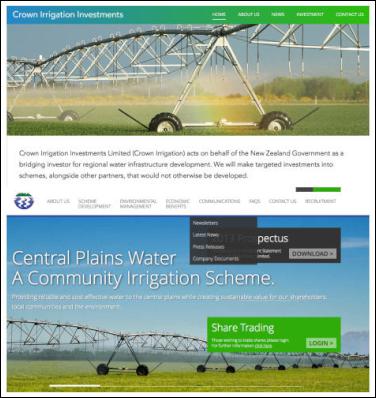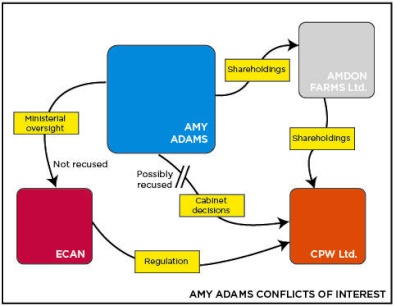Special Investigation: Adams Family Values
Rebuilding Christchurch
Special Investigation: Adams Family
Values
By James Macbeth
Dann
March 12, 2014
An investigation late last year by the Herald and Keith Ng showed that a number of MPs, mainly National MPs, happened to own a lot of farms. This isn’t anything new – National has always been the party that represents farmers. The head of Federated Farmers just happens to be the finance minister’s brother. However, the Minister of the Environment Amy Adams’ significant land holdings in mid-Canterbury may by affected by some of the decisions that her government has made on the environment.
Adams owns a number of properties, but the ones of most interest are in two blocks. The first is in 9 titles, at Charing Cross. It totals 1,992,440m2, and has a rateable value of $4,700,000. The second is at Darfield, is in one title of 502,154m2, and has a rateable value of $1,050,000. What is interesting about these two blocks is that they are both within the area to be covered by the Central Plains Water (CPW) scheme. This is a controversial project that will take water from the Rakaia River and use it to irrigate an area of the Canterbury Plains between the Rakaia and Hororata Rivers.
Water has been a controversial issue in Canterbury for most of the last decade, due to the rapid expansion of dairying, and the pressure this has placed on limited water resources. This of course boiled over when the newly-elected National government sacked the democratically elected ECan (Canterbury Regional Council) in 2010. The reasons given for this were that it was “dysfunctional”, but documents obtained under the Official Information Act by the Press show that this wasn’t about so-called dysfunction, but vested interests lobbying for greater access to water.
Further to this, when the bill went to parliament to replace the ECan council with commissioners, it also made it much easier for the Minister to amend a Water Conservation Order (WCO) in Canterbury. A WCO is often compared to a “national park” for a water way – it recognises the environmental, cultural and recreational significance of the body of water, and makes it more difficult for it to be exploited. WCOs are the domain of the Ministry of the Environment – not the regional council; by tacking this clause onto the bill which was nominally designed to resolve the “dysfunction” at ECan, the government showed what they were really trying to do. A WCO was placed on the Rakaia River in 1988 – the river which CPW needed to draw from to ensure the viability of their scheme. This was lifted in 2013.
Work on the CPW scheme is only just about to begin. One of the problems getting the scheme off the ground has been a lack of funding – this is a very expensive project. Luckily, the government decided to take $400 million from the “Future Investment Fund” (aka asset sales) and put it into an Irrigation Acceleration Fund, administered by the Ministry of Primary Industries. Crown Irrigation was launched by the former Minister, David Carter. The MPI says that Crown Irrigation was set up to fund “community irrigation”. Central Plains describes itself as “community irrigation” – despite it having a $375 million price tag. It’s also worth noting the similarities between the CPW and CII websites.

In September 2012, David Carter (Minister of Local Government) and Amy Adams (Minister of the Environment) fronted the press to explain that they were extending the reign of the ECan commissioners until 2016 (the 2010 bill said that there would be elections in 2013). They argued that it was needed because of the earthquakes, but Adams went on to talk about freshwater management:
”It is critical for New Zealand that the planning governance structure for Environment Canterbury is stable, effective and efficient. To keep the freshwater management work on track, we intend to retain the limited appeal rights on decisions made by Environment Canterbury on plans and policy statements relating to freshwater management.”
The 2010 share register of Central Plains Water Limited shows that a company called AMDON Farms Limited owned 801 shares in CPW, doubling to 1602 shares in 2011. Amy Adams is a director and co-owner of AMDON, along with her husband Robert “Don” Donald Adams. The CPWL register also shows that there are 7 other people with the surname Adams who have shares in the scheme and live in and around Greendale, some of whom are related to Amy and Don.
The Central Plains Water scheme would not have been viable if the National government had not passed the ECan bill in 2010. The value of land with access to water for irrigation is greater than land which does not. Adams owns a large amount of land which is within the CPW water scheme, and also owns shares in the scheme itself. It is difficult not to conclude that the actions of this government, including Adams and Carter, have benefitted their farming portfolios.
Comment on this story at the RebuildingChristchurch blog
UPDATE 1 - March 13
A couple more questions for Amy
Adams
By James Macbeth Dann
March 13, 2014
I was going to write a few more questions about the Amy Adams post from yesterday, but Rob Salmond at Polity has already covered most of what I was going to say – and included a handy flow chart! I recommend you pop over and check it out.
"Yesterday, we discovered that Amy Adams owns part of Canterbury Plains Water, a firm that is running irrigation schemes in Canterbury. This is important because it reveals two potential paths through which Adams could use her public office to enrich herself, and her husband, and other family members. Those two paths are:
Through participating in government decisions that are explicitly about CPW; or
- Through participating in government decisions about the management of freshwater resources in Canterbury. These affect the profitability of CPW and the value of its shares, which gives rise to a conflict of interest under the Cabinet Manual (2.61)."
In addition to what Rob has brought up, there are a couple more questions I’d like answered. Was she at cabinet when the decision was made to create the Crown Irrigation scheme? Did she participate in discussions at a cabinet level about this policy which sees money from state asset sales given as a subsidy to irrigation schemes?
Adams is also leading the charge to gut streamline the Resource Management Act. What effects will these changes have on dairy farms? Will they make it easier or harder to get resource consent for taking water from rivers? What about consent to discharge effluent into waterways?
I think there are still a few outstanding questions here that should be easy enough for Minister Adams to answer if she is so adamant that this is nothing more than a smear campaign.
Comment on this story at the RebuildingChristchurch blog
UPDATE 2 - March 13
I ain’t gonna work on Maggie’s farm
no more
By James Macbeth Dann
March
13, 2014
One of Amy Adams’s major projects is the reform of the RMA. Rob Hosking has an interesting profile on her and her reforms. It’s worth considering the Federated Farmers response to these proposed changes. Here is a press release from about a year ago, when the change proposals were announced:
"The proposed reform is closely aligned to Federated Farmers 2008 reform package.
Federated Farmers has for a long time tried to get the balance right between what the public wants to protect and what that means to someone who wants to use their land. The RMA in our view currently leans too far towards protection. Our members will welcome the proposed inclusion of “the benefits of the efficient use and development of natural and physical resources,” in a revised section 6.
A newly drafted section 7, focussing on the efficiency of council process, could require councils to consider “an appropriate balance between public and private interests in the use of land”. Every council should ask itself that same question every time a decision is made."
The changes that Adams is proposing are “closely aligned” to the reforms that Federated Farmers asked for in 2008. According to the Feds, the current RMA “leans too far towards protection” and they welcome wording which euphemistically refers to efficient use of resources, and the dropping of the phrase “the maintenance and enhancement of amenity values”. These proposed changes have been criticised as shifting the balance too far towards the economy, at the expense of the environment. One of the most prominent critics was no less than the Parliamentary Commissioner for the Environment, Dr Jan Wright. Here is a joint release from 50 councils who submitted on the changes (ECan is notably absent from the group). The submission notes “strong concerns raised by the majority of submitters that proposed changes will harm the environment”. Forest and Bird weren’t exactly keen on it either:
"The proposed weakening of the environmental safeguards in the Act’s purposes and principles are disappointing, unfounded and unrelated to the government’s objectives for simpler and consistent planning that leads to greater housing affordability."
Nor were Fish and Game, who commissioned Sir Geoffrey Palmer – the original architect of the RMA – to write a report on the changes.
In his report for the New Zealand Fish and Game Council, Sir Geoffrey’s expert analysis clearly shows that the Government’s proposed changes ‘will significantly and seriously weaken the ability of the RMA to protect the natural environment and its recreational enjoyment by all New Zealanders’
There is widespread opposition from a broad-range of groups about the impact that these changes will have on our environment. The common theme seems to be that these changes are designed to make it easier and faster to extract resources (read: water). So is the Minister of the Environment acting in the best interests of Federated Farmers, or herself? Or are they one and the same?
Comment on this story at the RebuildingChristchurch blog
ENDS
Republished
with permission.



 Gordon Campbell: On The Government’s Latest Ferries Scam
Gordon Campbell: On The Government’s Latest Ferries Scam Peter Dunne: Dunne's Weekly - While We're Breaking Up Monoliths, What About MBIE?
Peter Dunne: Dunne's Weekly - While We're Breaking Up Monoliths, What About MBIE? Adrian Maidment: Supermarket Signs
Adrian Maidment: Supermarket Signs Ian Powell: Revisiting Universalism
Ian Powell: Revisiting Universalism Martin LeFevre - Meditations: In A Global Society, There Is No Such Thing As “National Security”
Martin LeFevre - Meditations: In A Global Society, There Is No Such Thing As “National Security” Binoy Kampmark: Secrecy And Virtue Signalling - Another View Of Signalgate
Binoy Kampmark: Secrecy And Virtue Signalling - Another View Of Signalgate